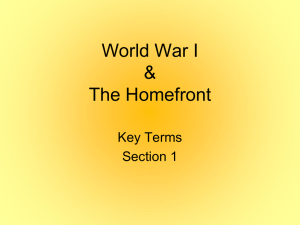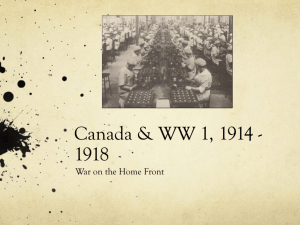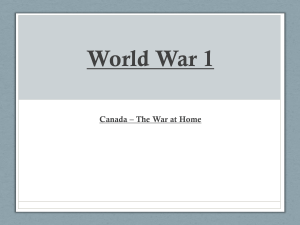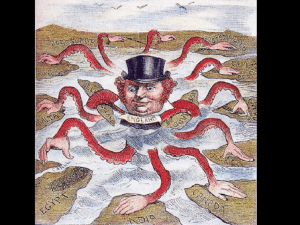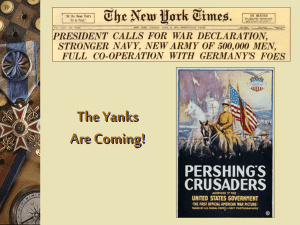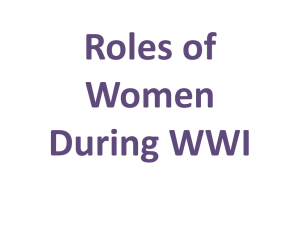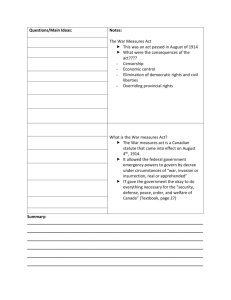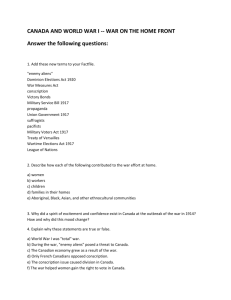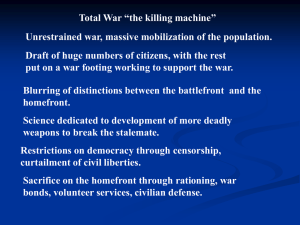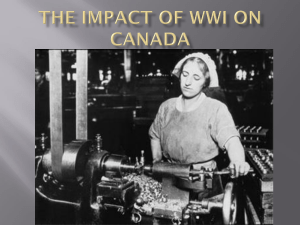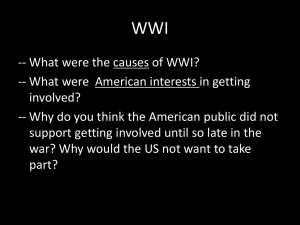The War on the Home Front World War I Due Friday Oct 28th
advertisement
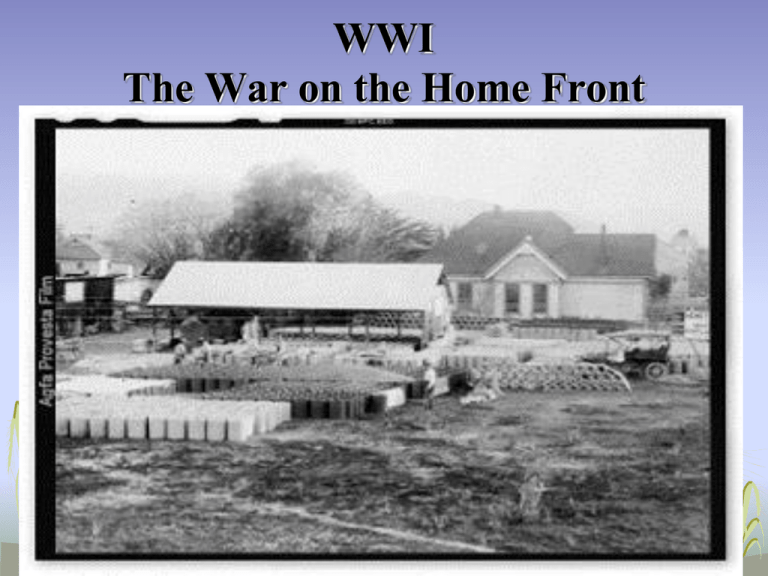
WWI The War on the Home Front The Government During WWI, the Federal government dramatically increased its intervention in the Canadian economy and society The War Economy The government in: 1916: introduces the War Profit Tax (25% if profits > 7%) 1917: introduces personal income tax 1917: nationalizes half of the railroads 1918: increased the civil service to 40,000 The War Economy (cont’d) The government organizes military production through: • Sam Hughes minister of militia. Was in charge of Canada’s armament industry. Created the Shell Committee by 1917 about 1/3 of shells used by British forces were produced in Canada. He was a poor administrator. Some of the shells had holes in them and exploded before being fired. Hughes took advantage of his position to give gov’t contracts to friends who were Profiteers. In one case, soldiers were equipped with boots made of pressed cardboard, that fell apart in the rain. He was also responsible for the Ross Rifle, that tended to jam when fired making it dangerous to use The Imperial Munitions Board: set up to stop profiteering (by 1917,war production is the biggest Canadian business: 600 factories, 150,000 workers, $2M/day) • The War Purchasing Board • The National Services Board Financing the War Cost: $1.3 billion by March 1919 > $1 million/day in 1918 Public Debt: 1911: $350 million 1918: $1,175 million Financing: 1. Victory Bonds: > $1.0 billion > 1 million citizens 2. Income Tax: ~ $8 million/yr The War Measures Act • • • Passed in August 1914 Empowers the gov’t to do anything “necessary for the security, defense, peace, order and welfare of Canada” Consequences: 1. Censorship 2. Economic control 3. Eliminating democratic rights and civil liberties (ex. a crime for males over 16 to be unemployed) 4. Overriding Provincial rights Halifax Explosion • On Thursday, December 6,1917 the City of Halifax, Nova Scotia, Canada, was devastated by the huge detonation of a French Cargo ship the Mont-Blanc , fully loaded with wartime explosives, that had accidentally collided with a Norwegian the Imo, ship in "The Narrows" section of the Halifax Harbour. Approximately 1,500 people were killed instantly, another 500 people died shortly after from wounds caused by debris, fires, or collapsed buildings, and it is estimated that over 9,000 people were injured. This was the largest artificial explosion until the first Atomic Bomb test explosion in 1945 and is still one of the world's largest artificial non-nuclear explosion to date. The German’s were blamed inaccurately for this explosion. Internment of “Enemy Aliens” • 1914: 500,000 people are of German, Austro-Hungarian or Ottoman Empire origin • 8,579 people (3,000 Canadian citizens) are put in 26 camps • The work: clearing land, building roads • The pay: 25 cents a day Democracy? • Election: Nov. 25, 1917 (also called Khaki election) • Sept. 1917: The Military Voters Act is passed • The vote is granted to all men and women in the Canadian Expeditionary Force • Sept. 1917: The Wartime Elections Act is passed • The vote is granted to all wives, sisters, mothers and daughters of soldiers • Outcome of the Election: The Union Gov’t wins (under the Conservative Party) Conscription The issue of conscription divides Canadians: farmers, the Quebecois, British loyalists, families of soldiers . . . Jan. 1918: Conscription imposed 400,000 affected 100,000 drafted 24,000 soldiers sent to France Riots and protests: 4 killed in Quebec city Propaganda within the School Systems Women and WWI WWI advanced the position of women through: • Their essential role in war production (30,000) • Their volunteer work to support the troops • Their service in the Royal Air Force (1,000) and as nurses (2,000) • This supported their demand for the vote, which was achieved That’s It Folks!!!
